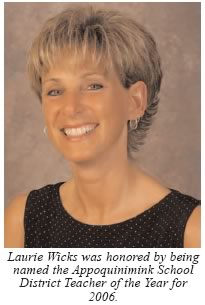|
Volume 13, No. 4, Fall 2005 |
Subscribe to AT Messenger Download PDF Viewer |
| PDF Version (for printing) Large Print (PDF) Text Version |
Universal Design for Learning Changes Curriculum
Laurie Wicks, Teacher, Silver Lake Elementary,
Appoquinimink School District
 Today’s educators must face the challenge of instructing identical curriculum to all students with the expectation that the students all meet the same standards of the high stakes tests. Understanding what our charge is, we face the problem that the classroom is more diverse than ever before. This diversity takes many forms, including academic, cultural, emotional, and physical. Knowing who the children are and how their backgrounds affect their learning is just one piece of the puzzle in helping students succeed. What is more important is that each teacher needs to respond to the students’ individual differences by using a variety of instructional strategies and tools to accommodate learning differences, allowing all students to succeed. Universal Design for Learning (UDL) is the framework that I now embrace in my instructional planning to meet the needs of the diverse learners in my classroom.
Today’s educators must face the challenge of instructing identical curriculum to all students with the expectation that the students all meet the same standards of the high stakes tests. Understanding what our charge is, we face the problem that the classroom is more diverse than ever before. This diversity takes many forms, including academic, cultural, emotional, and physical. Knowing who the children are and how their backgrounds affect their learning is just one piece of the puzzle in helping students succeed. What is more important is that each teacher needs to respond to the students’ individual differences by using a variety of instructional strategies and tools to accommodate learning differences, allowing all students to succeed. Universal Design for Learning (UDL) is the framework that I now embrace in my instructional planning to meet the needs of the diverse learners in my classroom.
During the 2004/2005 school year, an opportunity to participate in an initiative promoting UDL in the State of Delaware came my way. Through participation in this professional development initiative, I learned the philosophy behind UDL, created a lesson based on the UDL approach, implemented the lesson, and reflected on both the success of the lesson and my experiences throughout the process. I worked with a team of educational professionals from the Delaware Department of Education, the DATI, and educators from around the state. The collaboration among team members was critical to my understanding of the elements of the UDL framework. Our conversations focused on lesson goal setting, strategies in instruction, using a variety of materials including media to differentiate lessons, and creating assessments that evaluate student understanding accurately.
As I reflect on my experiences over the past year, I walk away with a variety of thoughts and struggle with which one is most important. First, I’d like to focus on the collaboration throughout the process. The team of professionals that was brought together for this experience has ranked second to none in my ten years of teaching. All of the individuals who participated were extremely knowledgeable in their subject matter, respected each other’s thoughts and comments, and were supportive throughout the entire process. Our conversations were imperative to fully understanding the UDL framework, but also included many sidebars on educational trends and hot topics. I always walked away from meetings with a feeling that my contributions to conversations were taken seriously. I also gained insight and tips from others to take back and digest.
Equally important to the team collaboration was how this experience has made me a better educator. I now look at my overall instructional goals and what objectives I have specified for my lessons. I concentrate on the strategies and methods I am incorporating in that lesson to ensure I meet the needs of the diverse learners and a variety of ways to access them. My focus is on accommodating the individual differences within my classroom. Not only are the students instructed with multiple means of representation, I now engage them by tapping into their interests and allowing them to demonstrate what they have learned through multiple means of expression.
Finally, the insight gained through collaboration and the improvement in my lesson planning, execution, and student assessment has impacted my students in a positive way. Given a variety of approaches to acquiring new material, the diverse population in my classroom now has a greater opportunity to be successful at learning and expressing their knowledge. All students in my classroom are actively engaged because they now feel they are part of the learning process. UDL helps to ensure that “no child is left behind.”
Note: Laurie Wicks was honored by being named the Appoquinimink School District Teacher of the Year for 2006.
DATI Receives Federal and State Endorsements
ATRCs Stock New Crick Software
Universal Design for Learning Changes Curriculum
Taking the Annual DSTP with Accommodations
LIFE and Inclusion Conference Dates Announced

